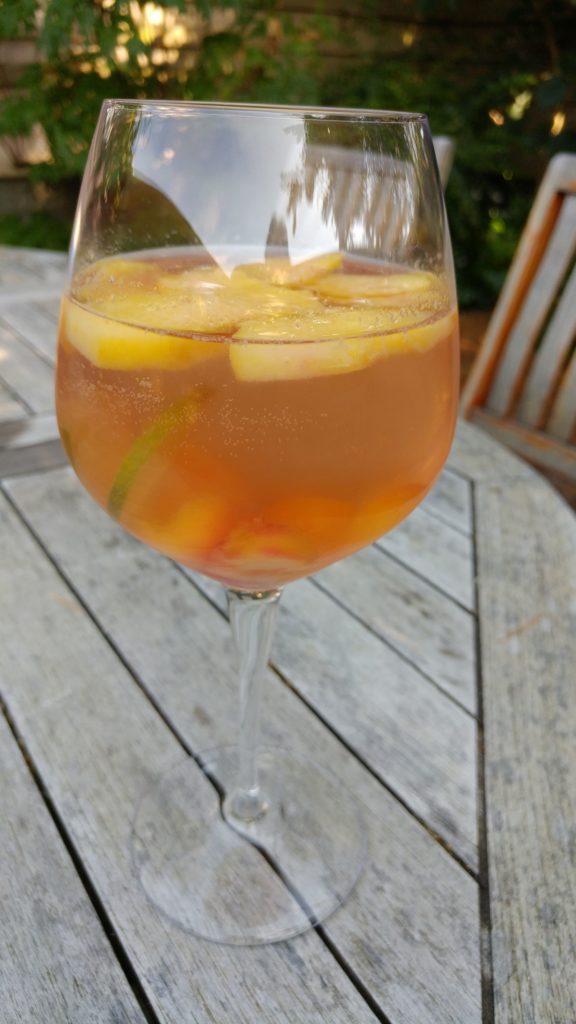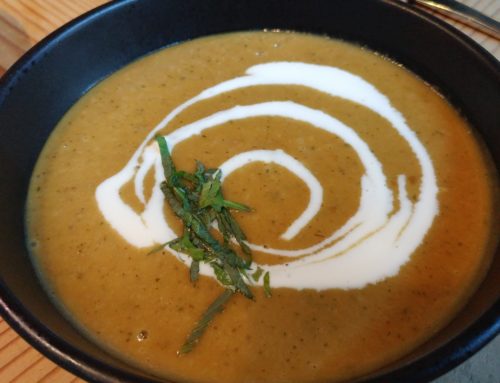I recorded a radio interview earlier this week, chatting about great foods and beverages to enjoy during the summer. When it comes to “summer” and “drinks” I get fixated on one thing: rosé sangria. I’ll admit to not usually being a sangria fan. Random fruit and sweetened red wine, just not my cup of tea. Which I’m sure is doing a disservice to great traditional sangria, but that’s been my general impression most times I’ve ordered it. Maybe I’ll have to run off to Spain and give some authentic sangria a try one of these days.
But when you swap out that red wine for a brisk, beautiful pink wine of summer and choose some great seasonal fruit  — now you’re talking! That’s a sangria I can get enthusiastic about. Pretty, bright, and delicious. An ideal partner for whatever you may be cooking up this summer.
— now you’re talking! That’s a sangria I can get enthusiastic about. Pretty, bright, and delicious. An ideal partner for whatever you may be cooking up this summer.
You know about the glories of rosé wine, right? Just because it’s pink doesn’t mean it’s sweet and adorable and girly. And if your only image of “pink” wine is white zinfandel, snap out of it!! Rosé is an incredibly engaging style of wine that serves up quite a lot of personality. Colors can go from just a subtle blush of pink to nearly raspberry, some verging on salmon-orange tones. Flavors range from light, crisp and quite dry to lush and somewhat fruity (my preference leans toward the former rather than the latter). While it’s possible some folks out there are in fact tinging white wine with red to get to pink, quality rosés are made with red wine grapes that are crushed, the juice left in contact with those red skins just long enough to influence the juice with a bit of their color.
So after I’d talked about some great grilling ideas and entertaining suggestions, the subject turned to beverages. And I piped up about my love of rosé sangria, about to rattle off description of the Watermelon-Rosé Sangria that’s in my new book, Gourmet Game Night, when I remembered that I’d also developed a rosé sangria recipe for my Stone Fruit cookbook that came out a few years ago. Kind of obsessed with the subject, you can see.
But here below is the original recipe I came up with. It was inspired in large part by the bottles of rosé from Washington’s own Chinook that populate our wine rack each summer. Winemaker Kay Simon makes her rosé with Cabernet Franc grapes, giving the wine some of that cherry-plum-berry character the varietal exhibits. If you’re unable to get your hands on the lighter-fleshed Rainier cherries, you can use dark cherries instead, knowing that their juices will deepen the color of the sangria from the natural hue of the wine.
Here’s to a wonderful summer ahead, with lots of delicious rosé sangria to enjoy! I think I’ll make it a new summertime tradition to come up with a new rosé sangria combo each year. A tasty challenge indeed.
Rosé Sangria with Rainier Cherries and Nectarines
from Stone Fruit
1/4 cup water
3 tablespoons sugar
2 bottles (750 ml each) dry rosé wine
1/2 pound Rainier cherries
1 nectarine or peach
1/2 lime, thinly sliced
1/4 cup brandy or kirsch
1 cup club soda
In a small saucepan, combine the water and sugar and warm over medium heat, stirring occasionally to help the sugar dissolve, 3 to 5 minutes. Increase the heat to high and bring just to a boil, then set the sugar syrup aside to cool.
Pour the rosé into a large pitcher, preferably glass. Pit and halve the cherries (Rainiers will discolor if pitted too far in advance) and add them to the wine. Pit and thinly slice the nectarine and add it to the pitcher with the lime slices. Stir in the brandy and sugar syrup, then chill the sangria until ready to serve, ideally at least a few hours to allow the flavors of the fruit to meld with the wine
Just before serving, stir in the club soda. Pour the chilled sangria into large wine glasses, spooning some of the fruit into each serving.
Makes 10 to 12 servings




You introduced me to Chinook rose’ quite some time ago. Thanks for the inspiration to lay in a few bottles and play. Cheers.
[…] Jump to Comments Okay, enough with the stone fruits! I’ve clearly been on a bent about that category of delicious summertime fruits. For a moment I’ll move along from the […]